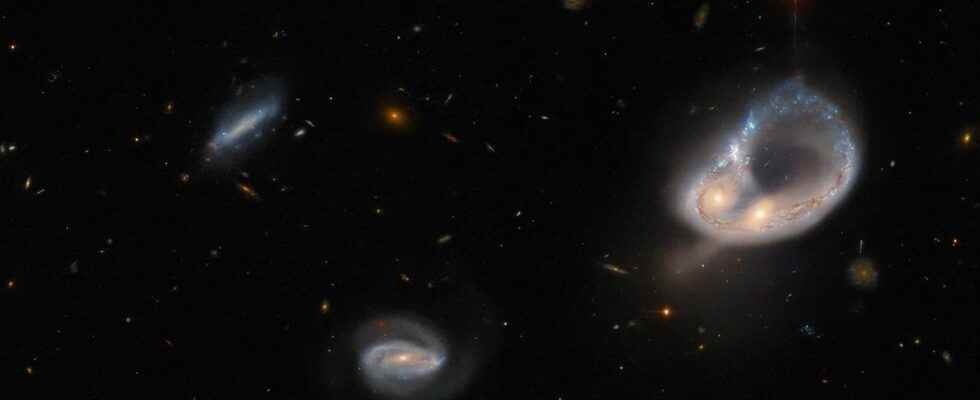We talk a lot about the James-Webb space telescope since its departure from Earth in December 2021 on an Ariane 5 rocket. We must not forget that despite its announced death, its predecessor, the venerable Hubble, continues to gratify us with images of course less defined, but still sublime.
In orbit around the Earth at an altitude of around 600 km, the instrument which should fall back to Earth by 2030 has turned its mirrors towards a very beautiful object from the Arp-Madore catalogue. He has just given us a very beautiful view of the Arp-Madore 417-391 galaxy collision, located some 670 million light-years away in the constellation of Eridanus, visible from the southern celestial hemisphere.
cosmic wedding
As NASA explains on its website,“the two galaxies were warped by gravity and twisted into a colossal ring, leaving their cores huddled side by side”. The ring in question is made up of stars from both galaxies.
In fact, this phenomenon is regularly observed, a fortiori when we turn to the oldest — and therefore distant — parts of the universe. At the beginning of its formation, the latter was smaller and the collisions of galaxies were all the more frequent. Moreover, our own galaxy, the Milky Way, will merge with our neighbor Andromeda in 4 billion years.
During these great cosmic marriages, the gas and dust of the objects involved mix, modifying the structures of the galaxies. And if one of the two always ends up disappearing to form a more massive set, it also results in zones denser in gas and dust which will generate the birth of new stars.
Hubble, 32 years of discoveries
To take this picture, “Hubble used its Advanced Surveillance Camera (ACS)”says NASA before adding that “this instrument is optimized for hunting galaxies and galaxy clusters in the ancient universe”.
The ACS has quite a few scientific discoveries to its credit. Installed in the early 2000s during the telescope’s 3B servicing mission, it replaced Hubble’s Faint Object Camera and took part in all sorts of activities, from mapping the distribution of enigmatic dark matter to studying the evolution of galaxy clusters.
Indeed, Hubble has been a major contributor to some of the greatest discoveries of our time. In addition to the detection of galaxies, supernovae and exoplanets, the acceleration of the speed of expansion of the universe, as well as the mechanisms that accompany them, it has made it possible to refine the age of the universe or even to find indirect evidence for the existence of supermassive black holes.
An impressive CV for the man who was nicknamed “the people’s telescope”. Let’s hope his successor James-Webb will do even better.
